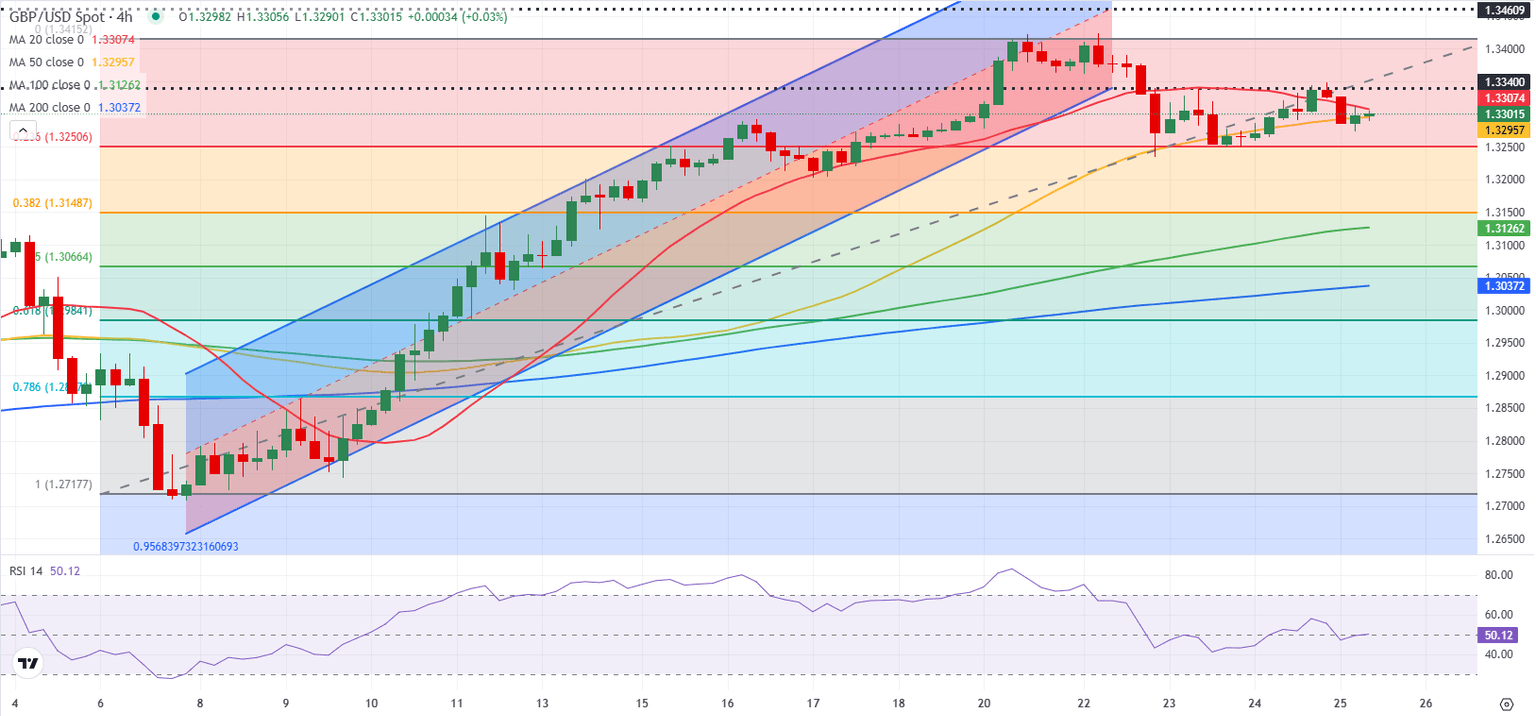GBP/USD Forecast: Pound Sterling struggles to attract buyers
- GBP/USD retreats to the 1.3300 region following Thursday's rebound.
- The technical outlook highlights a lack of buyer interest.
- Critical support level for the pair aligns at 1.3250.

GBP/USD stays on the back foot following Thursday's rebound and trades slightly below 1.3300 in the European session on Friday. The renewed US Dollar (USD) strength makes it difficult for the pair to hold its ground as investors remain focused on latest developments surrounding the US-China trade relations.
British Pound PRICE This week
The table below shows the percentage change of British Pound (GBP) against listed major currencies this week. British Pound was the weakest against the New Zealand Dollar.
| USD | EUR | GBP | JPY | CAD | AUD | NZD | CHF | |
|---|---|---|---|---|---|---|---|---|
| USD | 0.34% | -0.03% | 0.82% | 0.29% | -0.05% | -0.54% | 1.57% | |
| EUR | -0.34% | -0.52% | 0.46% | -0.09% | -0.57% | -0.90% | 1.21% | |
| GBP | 0.03% | 0.52% | 1.16% | 0.44% | -0.05% | -0.38% | 1.74% | |
| JPY | -0.82% | -0.46% | -1.16% | -0.53% | -1.00% | -1.24% | 0.77% | |
| CAD | -0.29% | 0.09% | -0.44% | 0.53% | -0.46% | -0.82% | 1.30% | |
| AUD | 0.05% | 0.57% | 0.05% | 1.00% | 0.46% | -0.32% | 1.79% | |
| NZD | 0.54% | 0.90% | 0.38% | 1.24% | 0.82% | 0.32% | 2.15% | |
| CHF | -1.57% | -1.21% | -1.74% | -0.77% | -1.30% | -1.79% | -2.15% |
The heat map shows percentage changes of major currencies against each other. The base currency is picked from the left column, while the quote currency is picked from the top row. For example, if you pick the British Pound from the left column and move along the horizontal line to the US Dollar, the percentage change displayed in the box will represent GBP (base)/USD (quote).
US President Donald Trump said late Thursday that a meeting between Chinese and US officials took place earlier in the day. During the Asian trading hours, Bloomberg reported that China was considering suspending its 125% tariff on some US imports, including medical equipment and ethane, and officials were having discussions about waiving tariffs on plane leases.
Although China's Foreign Ministry denied the news about US and China engaging in negotiations, investors remain optimistic about a further de-escalation of tensions. Hence, the USD Index stays in positive territory above 99.60 after losing 0.5% on Thursday.
The US economic calendar will feature the University of Michigan's revision of the April Consumer Sentiment Index, which is unlikely to trigger a market reaction. In case market mood remains upbeat heading into the weekend, GBP/USD could have a hard time gaining traction. At the time of press, US stock index futures were up between 0.1% and 0.5% on the day, pointing to a bullish opening in Wall Street.
GBP/USD Technical Analysis

The Relative Strength Index (RSI) indicator on the 4-hour chart moves sideways near 50, suggesting that the pair is struggling to gather directional momentum.
GBP/USD faces a critical support level at 1.3250, where the Fibonacci 23.6% retracement of the latest uptrend is located. If this support fails, additional losses toward 1.3200 (static level) and 1.3150 (Fibonacci 38.2% retracement) could be seen. On the upside, 1.3300 (static level, 20-period Simple Moving Average (SMA), 50-period SMA) aligns as first resistance ahead of 1.3340 (static level) and 1.3400-1.3410 (round level, static level).
Pound Sterling FAQs
The Pound Sterling (GBP) is the oldest currency in the world (886 AD) and the official currency of the United Kingdom. It is the fourth most traded unit for foreign exchange (FX) in the world, accounting for 12% of all transactions, averaging $630 billion a day, according to 2022 data. Its key trading pairs are GBP/USD, also known as ‘Cable’, which accounts for 11% of FX, GBP/JPY, or the ‘Dragon’ as it is known by traders (3%), and EUR/GBP (2%). The Pound Sterling is issued by the Bank of England (BoE).
The single most important factor influencing the value of the Pound Sterling is monetary policy decided by the Bank of England. The BoE bases its decisions on whether it has achieved its primary goal of “price stability” – a steady inflation rate of around 2%. Its primary tool for achieving this is the adjustment of interest rates. When inflation is too high, the BoE will try to rein it in by raising interest rates, making it more expensive for people and businesses to access credit. This is generally positive for GBP, as higher interest rates make the UK a more attractive place for global investors to park their money. When inflation falls too low it is a sign economic growth is slowing. In this scenario, the BoE will consider lowering interest rates to cheapen credit so businesses will borrow more to invest in growth-generating projects.
Data releases gauge the health of the economy and can impact the value of the Pound Sterling. Indicators such as GDP, Manufacturing and Services PMIs, and employment can all influence the direction of the GBP. A strong economy is good for Sterling. Not only does it attract more foreign investment but it may encourage the BoE to put up interest rates, which will directly strengthen GBP. Otherwise, if economic data is weak, the Pound Sterling is likely to fall.
Another significant data release for the Pound Sterling is the Trade Balance. This indicator measures the difference between what a country earns from its exports and what it spends on imports over a given period. If a country produces highly sought-after exports, its currency will benefit purely from the extra demand created from foreign buyers seeking to purchase these goods. Therefore, a positive net Trade Balance strengthens a currency and vice versa for a negative balance.
Premium
You have reached your limit of 3 free articles for this month.
Start your subscription and get access to all our original articles.
Author

Eren Sengezer
FXStreet
As an economist at heart, Eren Sengezer specializes in the assessment of the short-term and long-term impacts of macroeconomic data, central bank policies and political developments on financial assets.

















